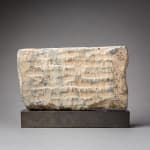Gandharan Schist Lintel Depicting the Division of the Buddha's Relics, 2nd Century CE - 3rd Century CE
Schist
12.7 x 21 cm
5 x 8 1/4 in
5 x 8 1/4 in
X.0522
Further images
An extremely rare depiction of the division of the Buddha’s relics at Kusinagara. This fragment would have belonged to a larger narrative cycle, almost certainly including the death of the...
An extremely rare depiction of the division of the Buddha’s relics at Kusinagara. This fragment would have belonged to a larger narrative cycle, almost certainly including the death of the Buddha. The central bearded figure is the Brahmin Drona who arbitrated the dispute over the Buddha’s cremated remains. The eight other turbaned figures represent the princely claimants. The figures to the left are well-preserved, particularly the full-length prince facing inwards, wearing an elaborate dhoti and holding a cylindrical reliquary with his portion of the ashes. The half-length figures behind the table wear heavy earrings and beaded jewellery to indicate their princely status. The table has elaborate turned legs and is hung with a finely worked drapery. A large amphora with an upturned spout is carved in relief in the foreground.
The division has clearly just taken place as the claimants are holding reliquaries in their hands. This was an incredibly significant event in the Buddhist narrative as it was believed that proximity to the Buddha’s remains would assist in the achievement of Enlightenment. By dividing them up, a greater number of his followers would be able to benefit from these sacred relics. (AM)
Other surviving examples of this subject can be found in H. Ingholt, Gandharan Art in Pakistan, (New York, 1957), pp. 97, no. 152 and p. 102, no. 167. See also W. Zwalf, A Catalogue of the Gandhara Sculpture in the British Museum, (London, 1996), Vol. I, pp. 207-208 and Vol. II. no. 232.
The division has clearly just taken place as the claimants are holding reliquaries in their hands. This was an incredibly significant event in the Buddhist narrative as it was believed that proximity to the Buddha’s remains would assist in the achievement of Enlightenment. By dividing them up, a greater number of his followers would be able to benefit from these sacred relics. (AM)
Other surviving examples of this subject can be found in H. Ingholt, Gandharan Art in Pakistan, (New York, 1957), pp. 97, no. 152 and p. 102, no. 167. See also W. Zwalf, A Catalogue of the Gandhara Sculpture in the British Museum, (London, 1996), Vol. I, pp. 207-208 and Vol. II. no. 232.





